Utah is a beautiful state known for having striking mountains and stunning rock formations caused by millennia of erosion. Another thing that Utah is known for is for having a large number of native snakes. The mountains, semi-desert, and rocky landscape are the ideal habitats for more than 30 different kinds of snakes.
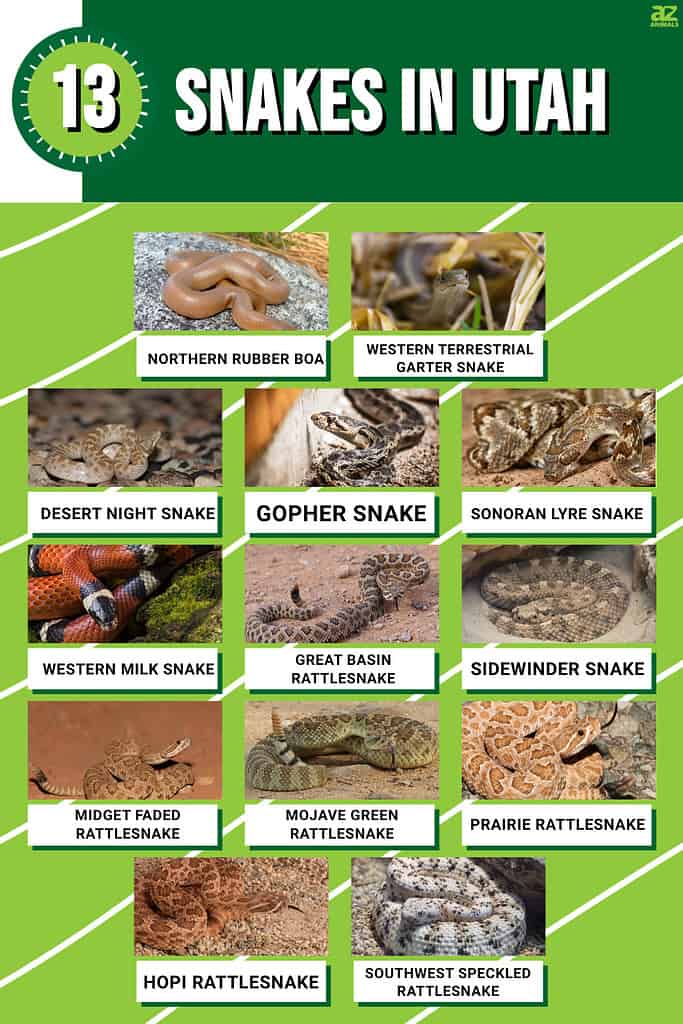
Utah is particularly known for being “rattlesnake country” because it has many different kinds of rattlesnakes that live in the state. In fact, all of the venomous snakes that live in Utah are rattlesnakes or a type of snake related to rattlesnakes.
So when you’re in Utah you must always have one eye on the ground in front of you scanning for movement so that you don’t surprise a venomous snake.
Non-Venomous Snake in Utah
There are other types of snakes in Utah that are not venomous. In fact, most of the snakes that live in Utah aren’t venomous. Some of the most common non-venomous snakes in Utah include:
Northern Rubber Boa (Charina bottae)
Rubber Boa aren’t venomous and even though they are boas they are harmless. They constrict their prey, but not people. These boas are pretty laid-back snakes and their docile nature makes them excellent snakes to help people get over their fear of snakes. Northern rubber boas have a glossy gray or olive appearance and their scales give them the appearance of a wet piece of rubber. That’s where their name comes from. They are usually about three feet long.
They like to hide in rocks, which is why Utah is the perfect home for them.
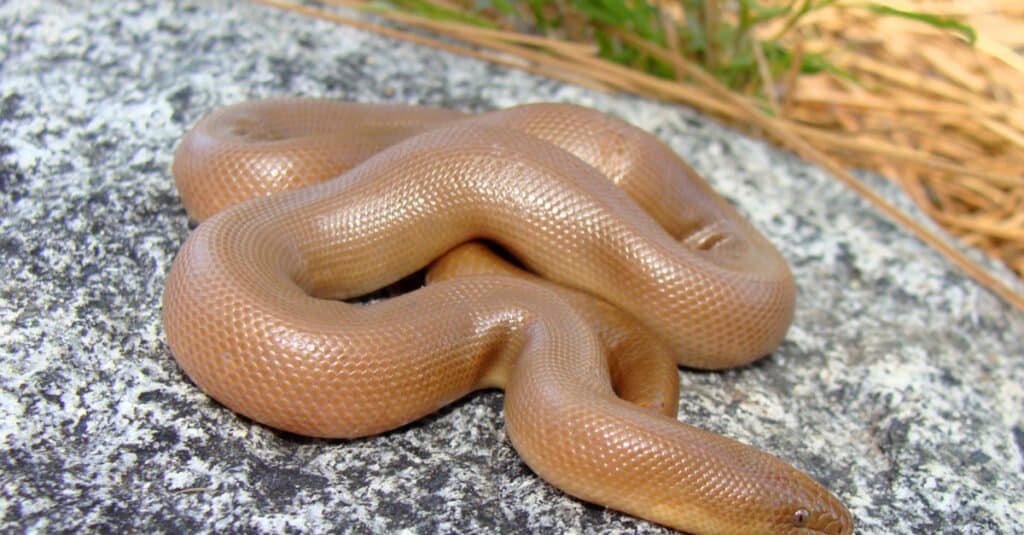
Rubber Boa Snakes like to hide under rocks, which is why Utah is a perfect place for them to live.
©Matt Jeppson/Shutterstock.com
Western Terrestrial Garter Snake (Thamnophis elegans)
These Garter snakes are very common in southwest Utah. They like rocky habitats and can be found in Zion National Park or the Pine Valley Mountains. They also can be found in the Red Cliffs Desert Reserve area, near the Virgin River, and up in the Red Mountain Wilderness. Western Territorial Garter snakes have colors that match their surroundings. They are usually shades of tan or brown to blend into the rocky landscape but they can also be gray.
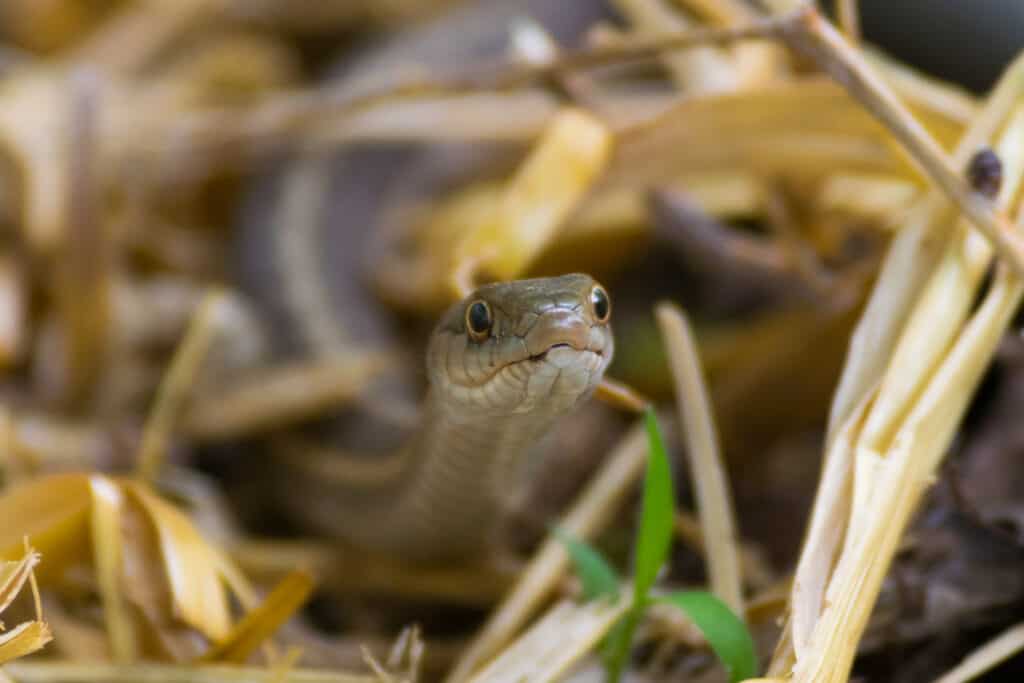
A Western Terrestrial Garter Snake found in a garden in Moab, Utah after surviving a bird attack.
©Will Pedro/Shutterstock.com
Desert Night Snake (Hypsiglena chlorophaea)
Night snakes are typically found in the Red Cliffs Desert Reserve area and throughout Utah. They are only about two feet long and are dark gray or dark brown. Night snakes are mildly venomous but harmless to humans. You probably wouldn’t even see a Night snake unless it crossed a trail right in front of you.
They only hunt at night and hide during the day. If you are starting a hike early in the morning or setting up camp after dark you might see one but most of the time you won’t see them.
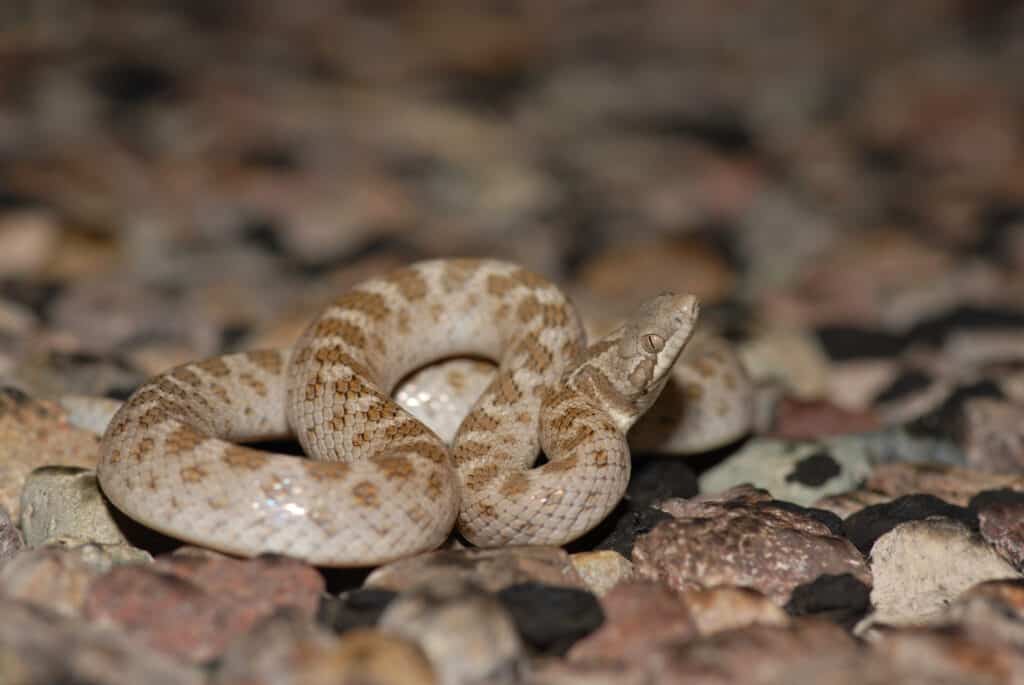
Night snakes aren’t venomous but they can release a mild toxin if they handled
©Rusty Dodson/Shutterstock.com
Gopher Snake (Pituophis catenifer)
Gopher snakes are one of the longest types of snakes. They can get to be over seven feet long, although typically they are just five to six feet long. Gopher snakes are typically light brown or light gray with dark brown or dark gray markings. What’s unique about Gopher snakes is that they can climb trees, hide under rocks, and make a home just about anywhere. Anytime you are out in an area where there are trees in Utah make sure that you’re looking above you as well as at the ground below to watch out for Gopher snakes.
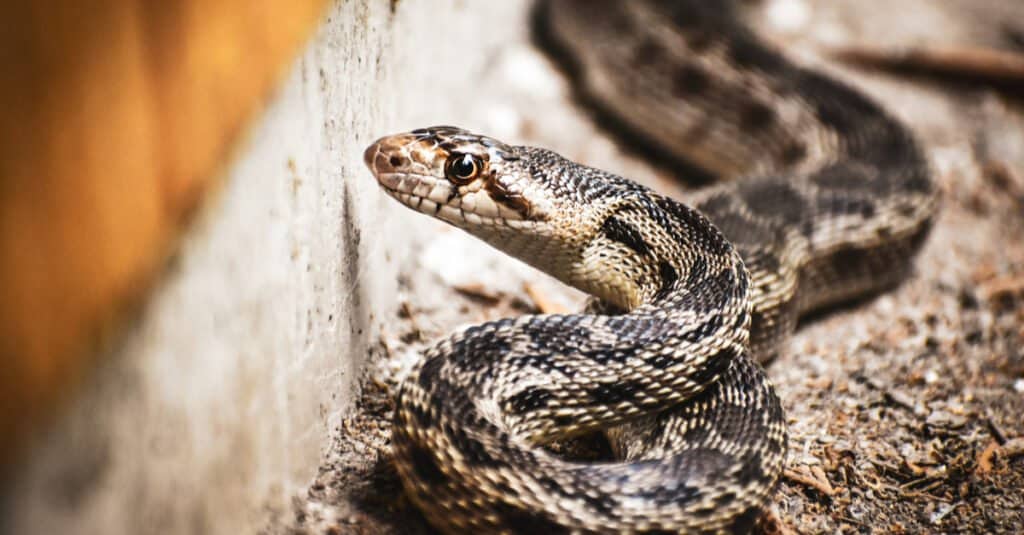
Gopher snakes like to climb trees. Anytime you are out in an area with trees in Utah, be sure you are looking above you as well as below.
©Cedar Dobson/Shutterstock.com
Sonoran Lyre Snake (Trimorphodon lambda)
Sonoran Lyre snakes are on the small side and don’t usually grow more than three to three and a half feet. Like many of the other snakes in Utah they tend to have gray and brown colorations that help them blend into the rocks and landscape. But Sonoran Lyre snakes will mimic deadly rattlesnakes in an attempt to protect themselves from predators.
So if you see a Sonoran Lyre snake don’t be fooled by its performance. It may rattle against leaves to mimic the rattle of a rattlesnake or even raise up like a rattlesnake. But it has no venom and won’t hurt you. It will often flee rather than fight given the chance.
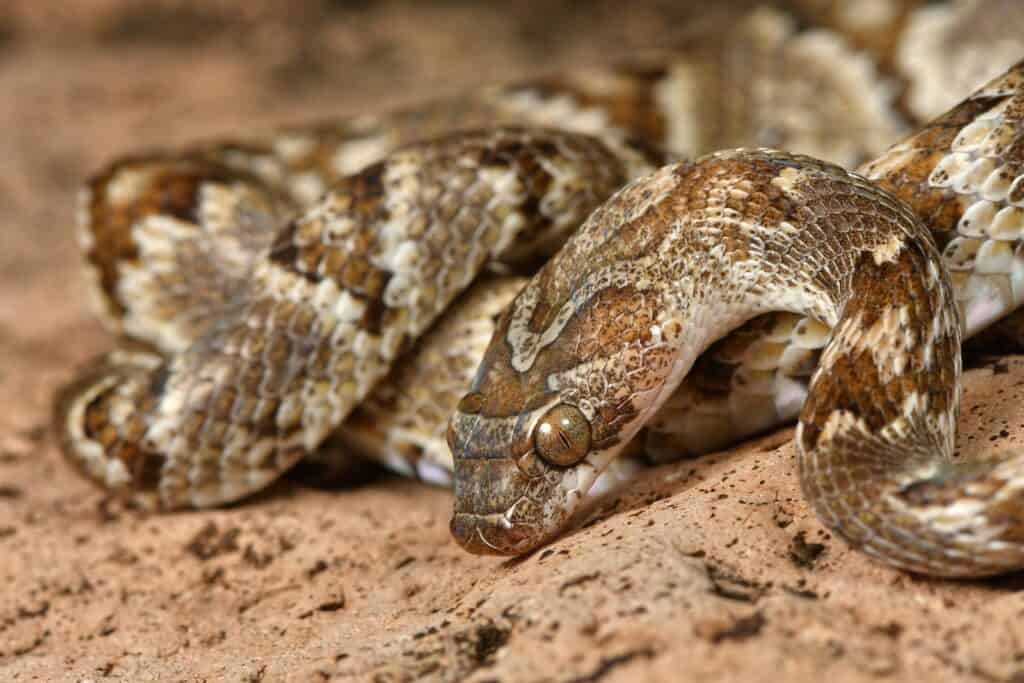
Sonoran Lyre snakes will mimic deadly rattlesnakes in an attempt to protect themselves from predators.
©Jon Bolton/Shutterstock.com
Western Milk Snake (Lampropeltis gentilis)
Milk snakes are also fakers in the snake world. They have incredibly bright bold coloration that mimics the colors and patterns of a highly venomous Coral snake. But Milk snakes are not venomous. You can tell if a snake is a Milk snake or a Coral snake by looking at the color of the two thin bands bordering the wide red bands on the snake’s back.
If the bands on either side of the red stripe are white it’s Coral snake. If they are black then it’s a Milk snake and it’s not dangerous to you.
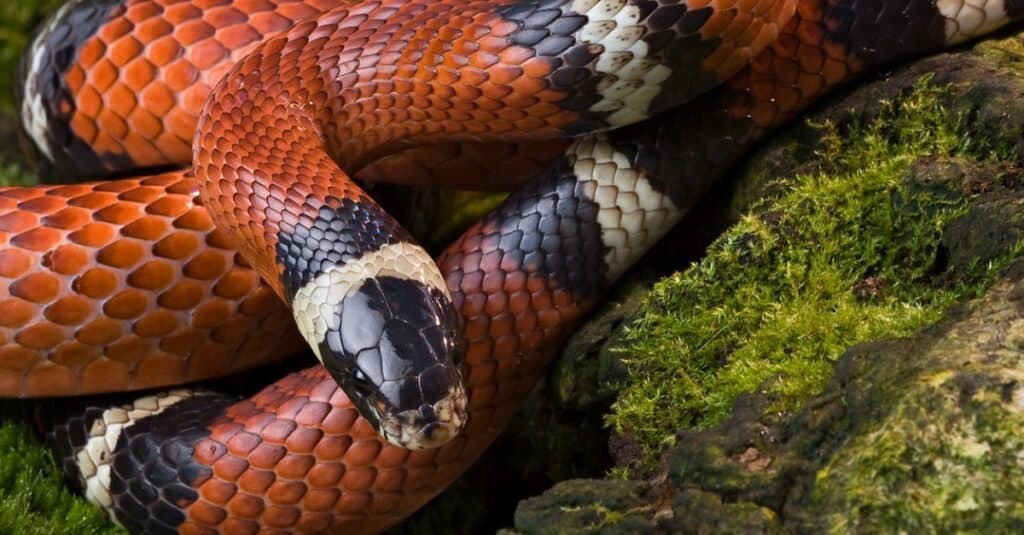
All species of milk snakes have alternating colors of light and dark.
©iStock.com/wScottLoy
Venomous Snakes In Utah
Utah is unique because all of the venomous snakes in this state are rattlesnakes except for the Sidewinder, and the Sidewinder is actually related to rattlesnakes. There are a lot of venomous snakes in Utah so be sure that you’re always paying attention to what is around you even if you’re just out doing work in your yard so that you don’t surprise a venomous snake. The types of venomous snakes in Utah are:
Great Basin Rattlesnake (Crotalus lutosis)
Great Basin rattlesnakes are active in the southwestern part of Utah. Their primary color can be gray, tan, brown, olive, or yellow and they typically have dark brown markings. They are only between two and four feet long so they aren’t that large but they blend into the surroundings extremely well. They have exceptionally sharp senses so they might know that you’re close before you know you’re close to them. Anytime you hear a rattle when you’re outdoors take immediate precautions to avoid an encounter with a venomous snake.
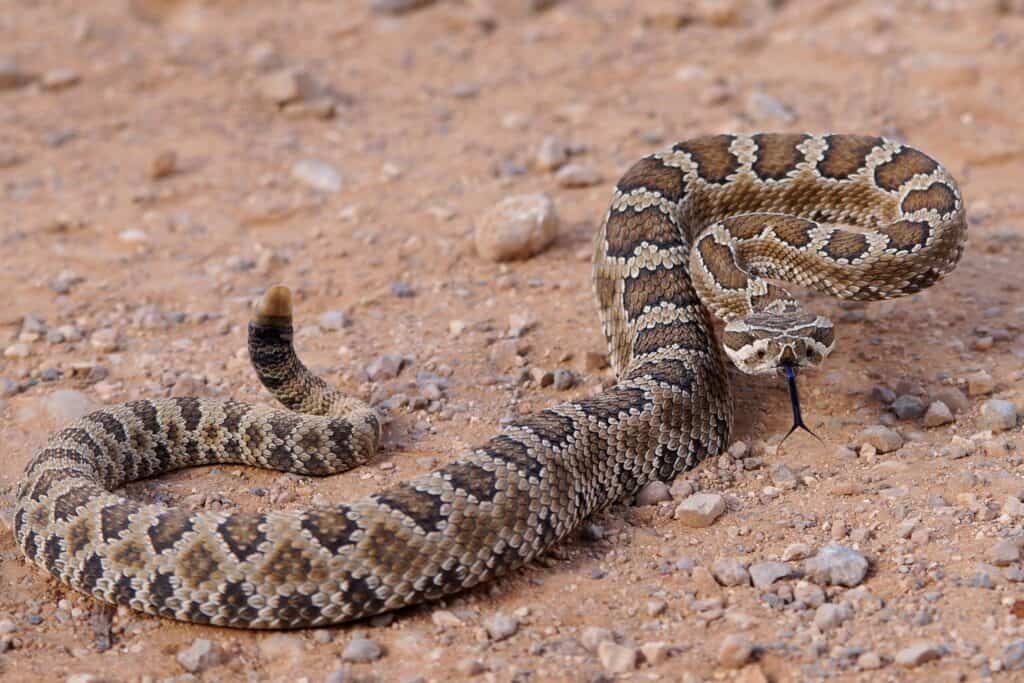
Great Basin Rattlesnakes are only between two and four feet long so they aren’t that large but they blend into the surroundings extremely well.
©Matt Jeppson/Shutterstock.com
Sidewinder Snake (Crotalus cerastes)
Sidewinders are sometimes called horned rattlesnakes because they have a unique headshape that makes it look like they have two horns on their head. But the most unique thing about a Sidewinder snake is the way it moves. Instead of slithering along the ground Sidewinder snakes will pick themselves up and form an S shape with their body.
The S shape allows them to propel themselves forward but in a sideways motion. Some experts theorize that this type of motion evolved because the snake’s primary habitat is on hot sand. The S shape allows the snake to move freely in loose sandy soil and avoids as much contact with the hot sand as possible.
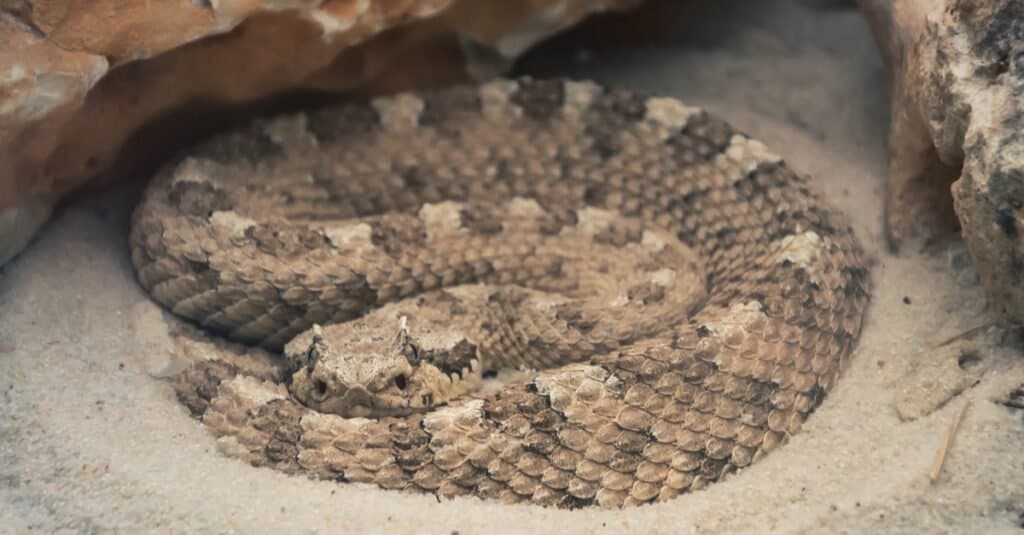
A Sidewinder Snake is named for the S shape they form with their bodies as they move.
©RA fotografia/Shutterstock.com
Midget Faded Rattlesnake (Crotalus concolor)
As you may have guessed from this snake’s name it’s small for a rattlesnake. It’s less than three feet long which is not as long as a typical rattlesnake but not as small as a pygmy rattlesnake. The scales on a Midget Faded Rattlesnake have a mottled appearance that makes it look faded. They are typically yellow, tan, or reddish brown.
But the most important thing to know about a Midget Faded Rattlesnake is that its venom is more toxic than many rattlesnakes. However, since they would rather avoid you, it’s not likely you’ll see one.
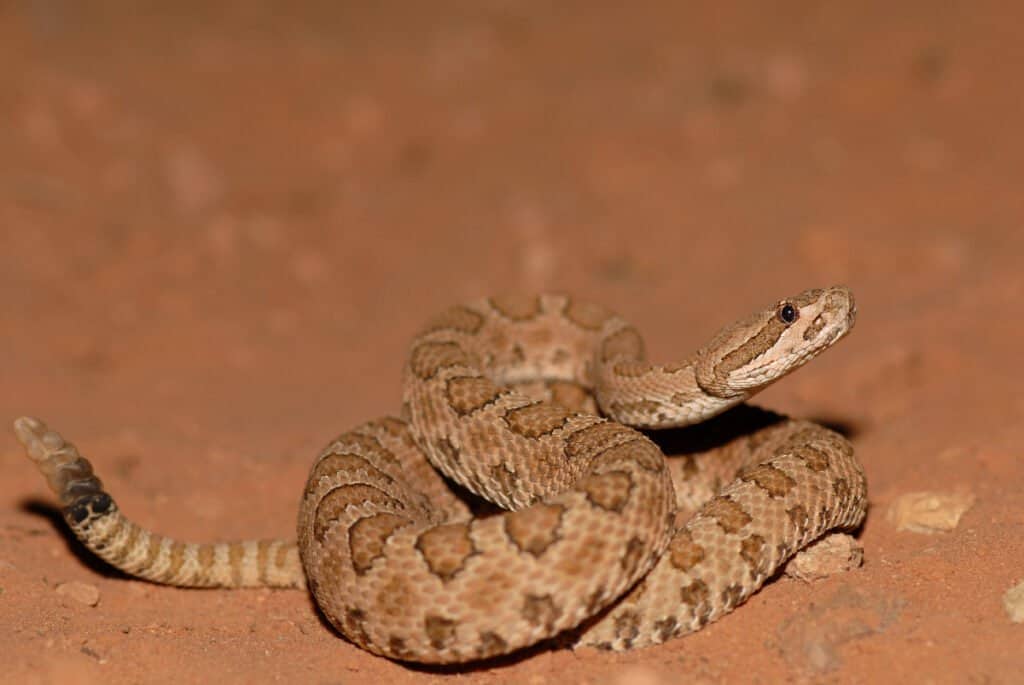
A Midget Faded Rattlesnake is one of the deadliest
snakes found in North America
.
©Rusty Dodson/Shutterstock.com
Mojave Green Rattlesnake (Crotalus scutulatus)
Another potentially very scary venomous snake in Utah is the Mojave Green Rattlesnake. Thankfully this snake only is found in the extreme southwestern part of Utah. Because the Mojave Green Rattlesnake may be even more dangerous than the Midget Faded Rattlesnake. Like most venomous snakes, the Mojave Green snake can deliver venom through its fangs even after it is dead.
The Mojave Green rattlesnake also has delayed venom. So if you are bitten by a Mojave Green Rattlesnake you may not feel any symptoms and think you are fine until it hits and then you’re in real trouble. However, the good news is that if you are bitten by a Mojave Green Rattlesnake you probably have time to get yourself to medical care before the venom starts to affect you.

The Mojave Green
Rattlesnake has a delayed venom
which causes one to feel like they will be fine. This makes them sometimes more deadly than the Midget Faded Rattlesnake.
©Creeping Things/Shutterstock.com
Prairie Rattlesnake (Crotalus viridis)
Like most rattlesnakes, the Prairie Rattlesnake is between three and five feet long. It has a light tan to light brown coloration but you may not ever see one. Most of the time this rattlesnake is nocturnal and only comes out at night to hunt.
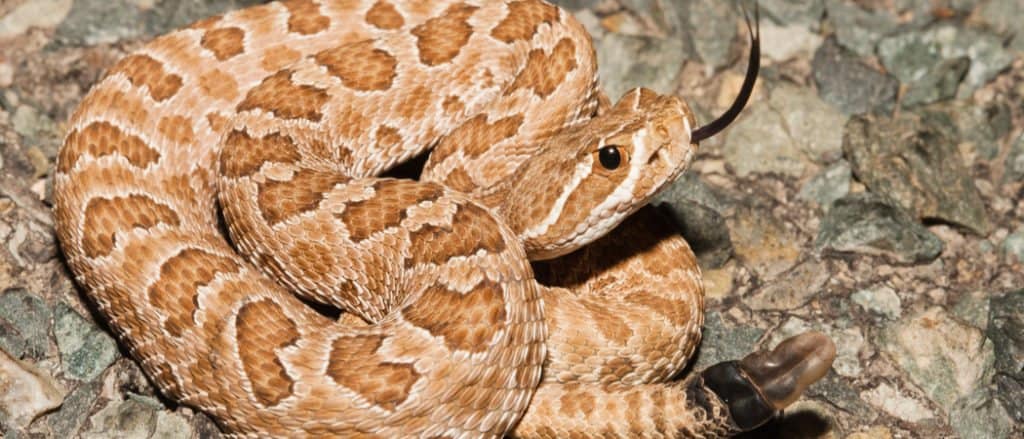
A Prairie
Rattlesnake is nocturnal and only comes out at night
to hunt.
©Nathan A Shepard/Shutterstock.com
Hopi Rattlesnake (Crotalus oreganus nuntius)
The Hopi Rattlesnake is similar in size and appearance to the Prairie Rattlesnake, but it’s smaller and usually isn’t longer than two feet. This snake is also nocturnal. It’s a very shy snake for a rattlesnake and if you do see one and you pause and give it a chance to flee it likely will flee rather than fight you.
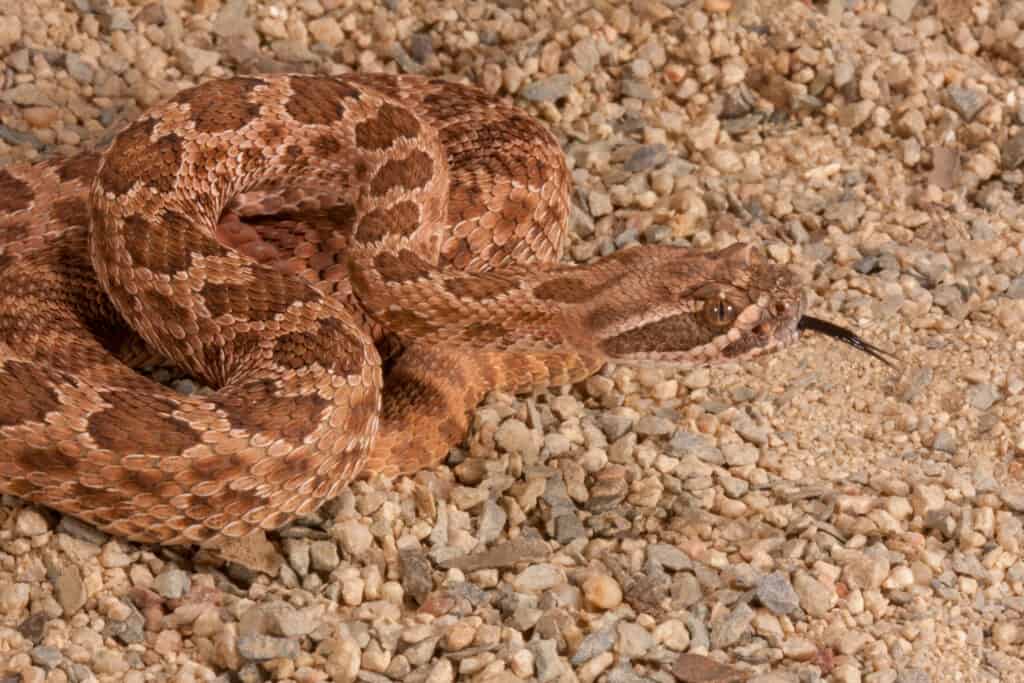
The Hopi Rattlesnake is a very shy snake for a rattlesnake and if you do see one and you pause and give it a chance to flee it likely will flee rather than fight you.
©K Hanley CHDPhoto/Shutterstock.com
Southwest Speckled Rattlesnake (Crotalus pyrrhus)
Another rattlesnake that is typically found in southwestern Utah is the Speckled Rattlesnake. This snake is unique because it is typically white or very light gray in color with black markings. The colors help it to blend into the rocks but when it’s out hunting you should be able to see the white body color clearly. Like the Hopi Rattlesnake the Speckled Rattlesnake tops out at about two feet so it’s not a large snake.
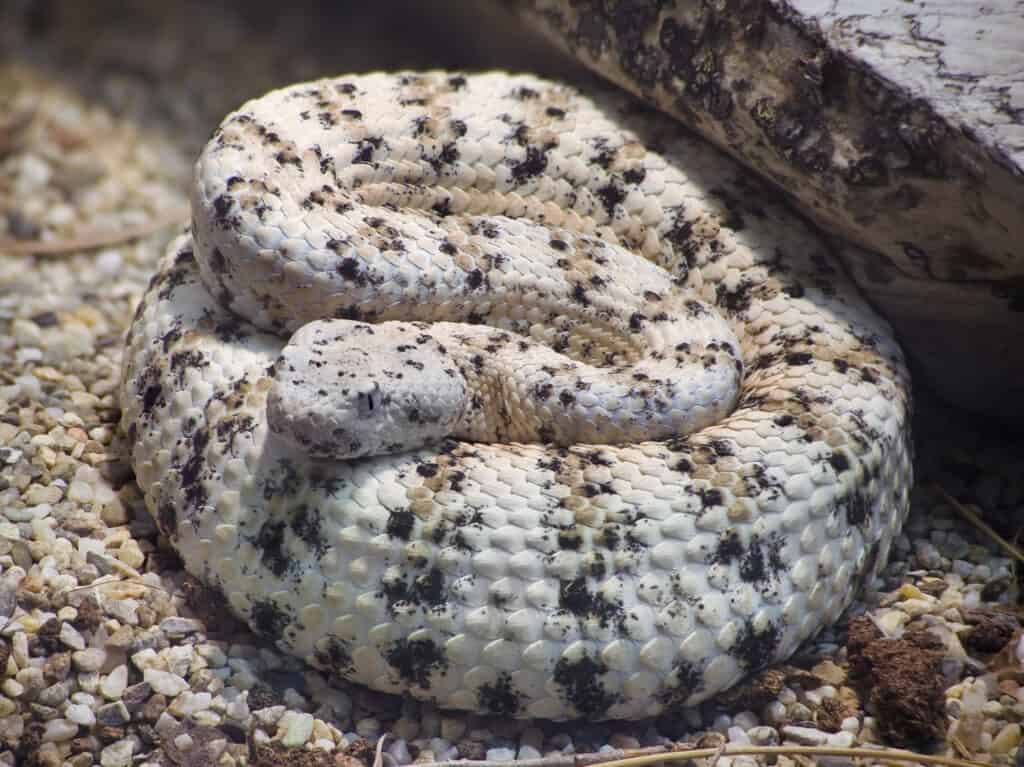
The Speckled Rattlesnake colors help it to blend into the rocks but when it’s out hunting you should be able to see the white body color clearly.
©Dario Sabljak/Shutterstock.com
A Complete List Of Snakes In Utah
Most people won’t get bitten by a venomous snake in Utah. But because there are so many types of snakes in this state, especially so many venomous snakes, it’s smart to keep your guard up and your eyes open whenever you are active in Utah.
The complete list of snakes in Utah is:
| Rank | Snakes in Utah |
|---|---|
| 1 | Rubber Boa Snake |
| 2 | Western Terrestrial Garter Snake |
| 3 | Sonora Mountain King Snake |
| 4 | Striped Whip Snake |
| 5 | Night Snake |
| 6 | Desert Night Snake |
| 7 | Western Patch-Nosed Snake |
| 8 | Long-Nosed Snake |
| 9 | Western Blind Snake |
| 10 | Gopher Snake |
| 11 | Glossy Snake |
| 12 | Western Ground Snake |
| 13 | Smith’s Black-Headed Snake |
| 14 | Western Lyre Snake |
| 15 | Milk Snake |
| 16 | Smooth Green Snake |
| 17 | Coachwhip Snake |
| 18 | Eastern Racer |
| 19 | California Kingsnake |
| 20 | Black-Necked Garter Snake |
| 21 | Spotted Leaf-Nosed Snake |
| 22 | Sonoran Lyre Snake |
| 23 | Ring-Necked Snake |
| 24 | Great Plains Rat Snake |
The photo featured at the top of this post is © Creeping Things/Shutterstock.com
Discover the "Monster" Snake 5X Bigger than an Anaconda
Every day A-Z Animals sends out some of the most incredible facts in the world from our free newsletter. Want to discover the 10 most beautiful snakes in the world, a "snake island" where you're never more than 3 feet from danger, or a "monster" snake 5X larger than an anaconda? Then sign up right now and you'll start receiving our daily newsletter absolutely free.
FAQs (Frequently Asked Questions)
Why is Utah called Rattlesnake Country?
All of the venomous snakes in Utah are rattlesnakes, except for the Sidewinder. There are many venomous snakes in Utah, so it is important to always be aware of your surroundings.
What is a Night Snake?
Night snakes are typically found in the Red Cliffs Desert Reserve area and through out Utah. They are only about two feet long and are dark gray or dark brown. Night snakes aren’t venomous but they can release a mild toxin if they handled. So it’s not a good idea to approach or handle a Night snake. You probably wouldn’t even see a Night snake unless it crossed a trail right in front of you.
Why are Milk Snakes called the “fakers” of the snake world?
They have incredibly bright bold coloration that mimics the colors and patterns of a highly venomous Coral snake.
Thank you for reading! Have some feedback for us? Contact the AZ Animals editorial team.







